Bicycle has often been considered a "suspicious" or even subversive means of transport, and has been for a long time the subject of bans. Indeed, this vehicle, invented in 1817 and, in its current version in 1884, was at the beginning a chic, expensive, and therefore elitist, vehicle reserved for the upper class who used it for leisure.
The earlier
cyclists
In Italy, the first velocipedes appeared in 1860, ridden by extravagant
nobles and upper class riders who aroused the curiosity and fear
of passers-by. (Fontana)
In 1869 the mayor of Milan absolutely banned "the use
of velocipedes in the whole area of the city enclosed within the
circle of the Navigli" since "the circulation
of velocipedes can be dangerous to the people who use them, as
to the public". In addition to the security reasons,
other mayors explained the prohibitions with the fact that the
"machine is frightening, even from a distance".
(Pivato,
1992)
The velocipede was not accessible to the lower classes who didn't
have time to spend for amusements, not to mention that the purchase
price of an Adler, Neumann, Swift,
(Italo Svevo's favourite) or Prinetti Stucchi bycicle was equal
to one year's wage of a worker, and that there was also a tax
to pay for it, to get a seal to be fixed to the frame by a metal
ring, the lack of which caused sanctions. (Lombroso)
At the beginning the
tax was municipal, the amount was 12 liras in Milan, and 6 in
Rome; then in 1897 the Chamber of Deputies approved a law that
established a tax of 10 liras for one-rider bicycles and 15 lire
for two-riders ones, equivalent to the current tax for a medium-sized
car, that even pushed somebody to steal
the seal.
The government at lenght promised the abolition of this tax. Antonio
Vicini, a member of parliament from Modena, who at the time belonged
to the extreme left, said to the Chamber of Deputies in the session
of December 14, 1907: “there is no reason that for an
object that costs 90 or 100 liras you have to pay, as in Italy,
a tax that represents a real loan-sharking”. (Tarantini) In 1909, the Parliament reduced
the tax to 6 liras, especially under pressure from the Touring
Club, which this way foresaw a greater diffusion of the bicycle.
(Pivato,
1992)
Mocking the bike tax, Lorenzo Stecchetti (Olindo
Guerrini, 1845-1916) wrote "It will not be long that
by the sovereign will you'll have a meter between your knees and
a tax disk on your butt." (Pivato, 1992)
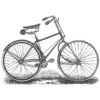
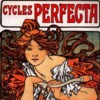

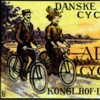


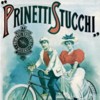

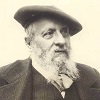
The popular and revolutionary
political forces at the beginning were strongly hostile to this
vehicle, and even more to cycling
sport. On June 23rd, 1894, the writer Alfredo
Oriani, author, among other works, of the 1902 book "Bicicletta"
("Bicycle"), inspired on his trip from Romagna
to Tuscany with a fixed-wheel Bremiamburg, and of the work on
the bicycle "Sul pedale" ("On the Pedal",
link, in
Italian), took part in Faenza at a demonstration against the
Mayor's ordinance of June 6th, forbidding "velocipedists"
to enter the city by bicycle. The seventy cyclists were welcomed
by Faenza citizens with hostile cries and hisses and were able
to leave the city only late in the night, escorted by light cavalrymen
(Dirani
and L'Osservatore
romano).
In Touring clubs, the bicycle became a tool for tourism, which
could fulfil the desire of bourgeois and popular classes to take
part in leisure (Pivato,
1992). On November
8th, 1894, the Touring Club Ciclistico Italiano
was founded in Milan, which since 1900 will be called Touring
Club Italiano, born to protect cyclists which were not members
of any sports club. Although the club was apolitical, according
its statute, it supported nationalist territorial claims, with
"patriotic trips" in areas of Italian culture, but belonging
to other states, such as Nice, Savoy, Canton Ticino, Trentino,
South Tyrol, the Karst and Trieste (Sbetti).
Irredentist cycling circles, claiming to redeem Friuli Venezia
Giulia, Trentino, Istria and Dalmatia from the the Austro-Hungarian
rule, were widespread in those areas, and organised trips in which
they crossed towns, where they were welcomed by the population
with patriotic songs, with great concern of the Austro-Hungarian
authorities. Also the choice of bicycles had a patriotic motivation,
preferring the Italian Bianchi, Gerbi or Panzera to the Austro-German Adler,
Pearl or Waffenrad (Pivato, 1992).
Queen Margherita was the first member of the royal house to become
a member of Italian Touring Club, and she loved to ride on the
avenues of the Royal Villa of Monza on her steel-made Bianchi
bicycle. Margherita had learned to ride a bike by Edoardo Bianchi,
the founder of the bicycle manufacturing company. The example
of the queen involved many aristocratic ladies of her court (Gori).
In Rimini in 1896 a political debate began about the trouble and
the accidents caused by the velocipedists, and it was also proposed
to establish a license, to be obtained by passing a qualifying
examination, before a commission appointed by the mayor "to
prevent non-experts from circulating in the streets",
then replaced by an affidavit. The administrative council
of the province, however, considered the imposition of a road
tax to be illegal. (Pivato,
1992).
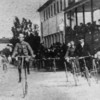
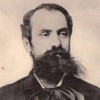

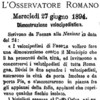


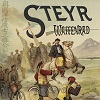

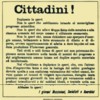

In those years a tourist
guide by the Italian Touring Club warned cyclists to avoid passing
through Emilia Romagna, and in particular Imola, in the province
of Bologna and Faenza, in the province of Ravenna, not to undergo
hooliganism, being cycling considered as an upper-class activity,
and therefore hostile to the working class. (Fontana). Initially, both Republicans and Anarchists
were against cycling. After the first edition
of Giro d'Italia (the cycling tour of Italy) which was held in
1909 , the Republican newspaper "La Giovane Italia"
called the Giro «a shame that dishonors the people
of Italy», while Republican Arturo Camprini
complained that in scarcely more than half an hour he had seen
selling 500 copies of the "Gazzetta dello Sport",
while in 5 days only 10 copies of "La Giovane Italia"
were sold (Pivato,
1992). A leaflet of the early 1910s,
signed by «the Young Socialists, Mazzinians
and Anarchists», beginning with «Blame the sport!» inveighed
against competitive sport, different from the one that is «nobly
meant for wonderful scientific progress» or is «an instrument of amusement and
pleasure» which could not be blamed «without
succumbing to the charge of being enemies of the progress and
of human improvement.»
The leaflet, on the other hand, condemned «sport, which, with its appeal
to a sudden fame and with the flattering of an immediate gain
due to a misunderstood appraisal of human values, due to the intent
of vulgar speculation, distracts so many precious young energies
from decisively different more truly noble and profitable intentions
and sublime ideals, and draws them on their fatal orbit, enslaves
them shamefully to the shady lucrative and supremacy aims of the
capitalist and bourgeois class of speculators and big industrialists
by throwing them, as a brutal and unconscious advertisement instrument,
in a crazy desperate race, scattered with all sorts of labor,
dangers, deaths», and lamented «the despicable spectacle of recklessness
and waste of energy that all those young cyclists offer at the
Giro d'Italia », defining it as one of the many
«one of the many traps drawn by the current
system of plutocratic and bourgeois government to the unaware
gullibility of the crowd.»
The close of the flyer was «Down with the sport!»
(Dirani).
The Italian Socialist Party stood for a long time clinging to
the certainty that sport was a miniature reproduction of the mechanisms
of capitalist war, which was organic to industrial or nationalist
speculations and even harmful to the body. Sport was nationalist
and clerical "a violent muscular reaction to the productive
inactivity of wealthy classes: so, the revenge of nature against
idleness and inactivity." (Petrini) The hostility of the Socialists was primarily
directed against competitiveness and the presence of rankings,
viewed as opposed to solidarity goals, so that their first competitions
did not include rankings, and the first meeting of the Socialist
Sports International in Ghent in 1913 discussed the proposal to
abolish rankings and awards.
Moreover, sport fuelled nationalism and militarism. The closeness
with militarism was confirmed by the fact that often the managers
of the gymnastics associations were generals, among them Fiorenzo
Bava Beccaris, who led the 1898 massacre in Milan against protests
for high prices and Luigi Pelloux, Prime Minister, twice Minister
of the interior and three times Minister of the war, responsible
for fierce antipopular repressions (Pivato, 1992). This
position, which was probably affected by the Socialist Party's
agricultural origins, led Benito Mussolini, at that time editor
of the 'Avanti!', to declare, on December 1st,
1912, thathe even wanted to scatter nails on the Via Emilia at
the passage of the cyclists of the Giro d'Italia (Sbetti). The young socialists defined
the participants of the Giro as "third-rate velocipedists"
and the socialist leader Giuseppe Zibordi
described the cyclist as "bent as a question mark on his
criminal buffalo-horn-shaped handlebars, he concentrates all his
physical and intellectual faculties in his feet" and
added: "It is actually sure that generally the runners
are only abnormal, with (very strong) trait of criminals".
The beginning
of the political use of bicycle
The situation changed when the bicycle became a means of transport
accessible to everyone thanks to the price reduction due to its
increasing diffusion and to the technological advancement. In
1893 the price of a bicycle was equal to 1655 hours of work, but
in 1913 it took only 357.
(Pivato,
1992) The price of
a Bianchi bicycle lowered from 300 daily wages of a worker at
the end of nineteenth century, to 100 wages ten years later. A
debate thus started inside the parties and the workers' organizations,
for and against the sporting practice. The Socialist Party's local
branch of Imola in May 1904 promoted a recreational society deeming
that "it is not a privilege of the bourgeois classes to
be able to live fraternally the collective life of the circles
and lodges". (Ridolfi)
Sport was also promoted as a tool for fighting alcoholism, scourge
of working classes. On August 31st, 1910, the journal "Sempre
Avanti!" ("Always Forward!") published
an article by his editor, Francesco Paoloni, who stressed how
alcoholism dehumanises and makes people insensitive to every ideal
exhortation, while «any brute less may be tomorrow
a militant more in the fighting army of proletariat.» (Giuntini)
Many revolutionaries refused cycling as a sport and bicycle as
a leisure tool, but accepted it as a symbol of modernity and as
a means of struggle, not only for reaching the workplace but also
for keeping links between occupied factories, to alert the workers
of the coming of law enforcement squads, to distribute the revolutionary
press, to reach and organize workers in the most isolated villages
and in the countryside, allowing them to take part in the demonstrations
in the cities. This "subversive" character of bicycle
also prompted ecclesiastical authorities to look at it with suspicion
considering it "real anarchy, comparable to hermaphroditism"
and even forbidding the priests to use it, under pain of disciplinary
actions even including suspension a divinis. (Izagirre, Pivato,
2011)
In 1910 a parish priest of a village near Ravenna had raised a
problem on the parish bulletin: can a parish priest who has to
rush urgently to the bedside of a seriously ill person "ride
a bicycle despite the higher hierarchical prohibition?"
and he gave himself a positive answer. ("He can").
The bishop of Faenza, having a different opinion, ordered the
seizure of the bulletin, confirming the absolute prohibition,
in every situation, because of the "great dissipation
that would have produced" a suspension, even partial,
of the ban. (Pivato,
1992) A short
piece of Rome newspaper Il Messaggero of 1894 testifies to
the transition of Catholic Church from refusal to acknowledgement
of the bicycle.





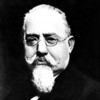

In the summer of 1894,
the Associazione milanese di ciclisti socialisti (Milanese
Association of Socialist Cyclists) had the purpose of propagating
socialist ideas and participating in cycling races to campaign
in favor of Leonida Bissolati. Again
in Milan, in 1896, the groups Pro Ideale and So-cialisti
in the fifth electoral constituency of Milan campaigned for Filippo Turati. (Senatori, 2011)
In 1898, during the
popular riots of Milan against
hunger, the infamous general Bava Beccaris with a ban
had forbidden the circulation of «bicycles, tricycles and tandem» in
order to prevent them from becoming a valuable means of communication
between insurgents.
Other active groups were "Forza e Costanza" ("Strength
and Perseverance"), the cycling section of Brescia cooperatives,
and "Club Ciclistico Avanti" ("Forward
Cycling Club") in Rome
(Senatori,
2011). Only
thanks to the red cyclists the fourth National Congress of Socialist
Party, held in Florence from 11th to-13th July, 1896, put the issue of
sport on the agenda
(Boschi).
In 1900 the criminologist Cesare Lombroso
(1835-1909) ended his article with a paragraph on the
benefits of cycling for welfare and civilization: «It
reduced isolation of small towns, put the countryside a few minutes
away from residential areas and capitals, it was an ally in election
to the political parties which are the most progressive, and therefore
know how to use the most modern means of fight.».
Lombroso also praised the benefits of the bicycle for mental health,
and concluded with a sentence that today seems definitely optimistic:
«the cicloanthropos
of twentieth century will suffer less of nerves, his muscles
will be more robust than those of the man of the last century.»
In the same article,
however, Lombroso warned against «the extraordinary importance
of the bicycle, both as a cause and as a tool of crime»,
and quoted many records of crimes committed to obtain the money
needed to buy a bicycle and become cycling champions or to sell
it, or to use the bicycle to escape quickly after a robbery.
The earlier
Red Cyclists
In the new century
the organized political use of bicycle had a strong development
in Emilia and Romagna, where Republicans, who at the time and
until the second postwar period were a radical and anti-clerical
political force, organized on July 26th, 1903 in Cervia their first regional
cycling meeting, with the participation of delegates from the
Marche, to emphasize the importance of the bicycle for the diffusion
of revolutionary ideas of Giuseppe Mazzini.
A convention of Republicans from Marche and Romagna was held in
the Republic of San Marino in August 1904, having great resonance
in the press (Pivato,
1992).
On June 12th, 1905, on the initiative of the
Socialists of Reggio Emilia, the
first group of Red Cyclists was founded: in front of the Cooperative
of Prato di Correggio, the cycling teams of Reggio, Bagnolo, Correggio,
Rubiera and San Martino in Rio gathered. The meeting was promoted
by the local Chamber of Labor to put at the service of workers
"a quick means of conversation for the great battles of
workers". The initiative was a great success, and shortly
thereafter the Provincial Association of Red Cyclists was established,
declaring: "The bicycle that has already become a useful
aid to the single worker must also become a powerful aid for collective
action in interest of the proletarian masses". (Pivato, 1992)
On April 10th, 1906, in Carpi, in the province
of Modena, the Unione Sportiva Socialista (Socialist Sporting
Union) was founded, open to members of the Socialist Party having
a bicycle, with the aim of «helping the Socialist Party
in the electoral struggles to organize propaganda and leisure
tours, socialist marches etc.».
In May 1906, members
of the Union organized a meeting against excessive taxation on
bicycles, and on June 3rd, 1907 in Carpi a gathering of
nearly five hundred cyclists from Reggio Emilia and Correggio
took place. (Giuntini)
In Reggio Emilia the Red Cyclists counted four thousand members,
divided into squads for each district of a municipality, and distinguished
by a red cap. In 1906 two thousand Red Cyclists took part in the
parade of May 1st feast; two days before, on Sunday,
April 29th, there was a preparatory meeting,
which was also a protest against bicycle traffic tax. The role
of cyclists was also to provide a fast-moving team of stewards
for demonstrations and parades. In June 1910, the Red Cyclists
organised a floral cycling contest. Numerous trips were organized
in the province and at the head of the squadrons always marched
the fanfare of «Veloce Club» ("Swift
Club"). The presence of cyclists at 1st May parade became customary, not
only in Reggio Emilia, but also in the cities of the province,
as Correggio, Guastalla, Scandiano,
Cavriago and Casoni. (Fincardi, 2012b) In
Romagna there was a lively competition between the Red Cyclists
and the Republican and Catholic cycling teams.
(Ridolfi)





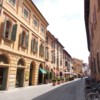


The Red
Cyclists in the years 1910s
The constitution of
a national organization of «Red Cyclists» was supported by Giovanni
Germanetto and Mario Montagnana,
who later became members of the Communist Party of Italy. On June
16th, 1912, the Regional Socialist Congress
at Imola, saw the birth of the «Red
Cyclists» («Ciclisti Rossi»),
a sporting company that had definitely political goals, rather
than sport. That day, seventy cyclists coming from Forlì
with a red band on their arm reached the congress welcomed by
applause (Giannantoni
and Paolucci) preceded by marching band and by their flag
(Boschi). The weekly journal "La Lotta", the organ of
the Socialist Federation of Imola, in the same day's issue explained:
«During the occasional periods of struggle (elections,
agitations, strikes, etc.), Red Cyclists will enable our committees
to have safe and fast means of communication and correspondence,
not only, but they will provide them with an already trained staff
and prepared to travel through the Municipality and the electoral
constituency, with a sufficient knowledge of places, people, etc.
Finally, in the great demonstrations, the squadron of the Red
Cyclists - which if the spirit and enthusiasm of all the comrades
will help, will always increase by number - will be worthy of
completing our parades, effectively assisting their organization
and giving them greater order and strength» (Fontana).
The socialist journal "L'Avanguardia" of September
8th, 1912 supported the thesis of using Red
Cyclists to carry out propaganda against sport among young people,
rather than making obstructionism to sports. (Pivato, 1992)
On Sunday, September 22nd, 1912, again in Imola, together
with the Socialist National Youth Congress, which took place in
Bologna from Friday 20th, the 1st National Red Cyclist Congress
was held (Zanelli),
attended by 700 Red
Cyclists from various regions, mainly from northern Italy, while
Arturo Vella, Amedeo
Bordiga and Anselmo Marabini delivered a speech. (Fincardi, 2012b) The
participants came from Bologna with a special train, they made
a stop at Piratello to pay homage to the tomb of Andrea
Costa. Born in Imola,
1851, Andrea Costa was one of the founders of socialism in Italy
and the first Italian socialist deputy, and had died at Imola
a few years earlier, on January 19th, 1910. The participants at the
congress then gathered at Carducci
schools, paraded through the streets of Imola, were taken
to the town hall, and visited the workers' and socialist institutions
of the city. According to the spirit of the gathering: "The
red bicycles want to serve our ideal, to support, to connect,
to keep alive our movement, our people in every district."
(Zanelli) An
anonymous editor on "La lotta" expressed opposition
to the passion for the bicycle: "We have not since yesterday
raised a vigorous protest against the sports obsession, which
for some time has invaded our working youth, distracting them
from their mind activities and from the daily struggle against
privilege" and again "ours is above all a spiritual
civilization. Physical education should not be detrimental to
intellectual education." (Zanelli)
The bourgeos newspaper
Corriere della Sera gave a negative interpretation of the conference,
seen as an antimilitarist demonstration, resulting in a "serious
brawl in front of a tavern frequented by nationalists." (Boschi)
In Reggio Emilia on May 1st, 1913, the Red Cyclists, after
parading through the city in the morning, went
in the afternoon to Cavriago to perform the boycott of the celebration
of Catholic associations. The same happened on 1st
May of the following year, at Quattro Castella (Fincardi, 2012b).
In the same year, 1913, the Lugo magazine «La Fiamma Socialista» («The
Socialist Flame») on the occasion of the celebration
of May 1st, wrote: «All the Red Cyclists from Lavezzola,
Conselice, San Patrizio, Massalombarda, Giovecca, San Bernardino,
Santa Maria in Fabriago and San Lorenzo will go to Sant'Agata
sul Santerno where the red cyclists of Villa San Martino and those
of Lugo will meet them to go all together at first at the red
organizers' house in Lugo, then to Andrea Costa monument, to deliver
the flowers of memory and promise.»
The third parade was organised on June 22nd,
1913, as second National meeting of the Socialist cyclists' groups.
Due to pouring rain, several delegations of cyclists, including
those of Turin, Venice, Reggio and Lugo, had to renounce to the
ride, while the delegations from Imola and the other who managed
to get there sloshing in the mud, were anyway able to dictate
the rules of their organizational circuit.







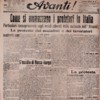
Imola saw, on August 10th,
1913, the foundation of the National Federation of Red Cyclists,
with more than a thousand members and seat in via
Appia, 7. On August 17th, 1913, the fourth meeting, presented
as the First National Meeting, that officially founded the Red
Cyclists Federation, being the Romagna town covered from wall
to wall with posters and banners and red flags waving. The Red
Cyclists Federation advised to wear a red shirt with the social
badge and, lacking the shirt, a red band arm with a black writing
"red cyclists team of ..." (Pivato, 1992).mA thousand cyclists, with delegations
from several towns in Romagna and Emilia took part in it. The
local socialist weekly journal described the meeting as «magnificent,
imposing and enthusiastic». The journal of FIGS (Youth
Socialist Federation) «L'Avanguardia» was by
then able to present the class-struggle riding on two wheels:
«Red Cyclists are and will be the forerunners of our
propaganda and of our movement, the fast channels by which our
people from each district and each country will always be entrusted
and connected, both in peace and in times of war.»
When the National Federation was founded, the Red Cyclists were
mainly spread in Emilia, in Romagna, in Milan and Turin, but relevant
groups existed in Pesaro, Florence, Sesto Fiorentino, Terni, Portici,
Castellamare di Stabia and Sparanise, in addition to Città
di Castello (see link,
in Italian), Reggio Emilia, Imola and Cesena, where squadrons
already existed since some years. (Fincardi, 2012b)
Again Imola, on August 24th, 1913, hosted the first Red Cyclists
National Congress, which approved a statute according to which,
in special periods (elections, agitations, strikes), Red Cyclists
were to ensure rapid communication and correspondence. The statute
continued by defining Red Cyclists as the avant-garde of socialist
propaganda and movement, and the means by which affiliates of
all districts could keep in touch, both in peace and in war. The
bicycle was defined as a "vehicle of the people"
at the service of the class struggle, and agonistic cycling was
blamed, defining sport as a serious problem that diverted the
attention of workers and particularly of young people, distracting
them from studying social problems and keeping them away from
political associations. All the young people who were more anxious
to read the sports newspaper La Gazzetta
dello Sport rather than the socialist newspaper "Avanti!" were also blamed,
since they took care only to make love and ride bicycle. (Izagirre)
At Imola, the Camera del Lavoro (Trade Union's local office) provided
services for red cyclists, publishing on her weekly journal "La
Lotta" advertisement like this: «Comrades! Do
you need bicycle tyres and inner tubes and do you want to spend
little money? Refer to the Camera del Lavoro at via Gamberini.
Standard goods at unbeatable prices.»
Program
of the Red Cyclists
In the founding document
of the new popular sports movement, written by the Red Cyclists
ideologist, Antonio Lorenzini, reported in an unpublished typewritten
document "Storia del ciclismo UISP" ("History
of UISP cycling", UISP is the National Union of Popular
Sports) by Sergio Giuntini, reads: "The Red Cyclists are
those who, knowing how and being able to ride a bicycle, never
make of this exercise, or maybe of this kind of passion, a goal
or an ideal. The goal of the Red Cyclists is propaganda: their
means is bicycle sport, if you like to call it so, contained within
human and dignified limits! Our cyclists do not mean and do not
want physical education to be detrimental to the intellectual
and moral education of their own or of others.
Yet, of bicycle sports - and maybe tomorrow of other sports
- they purely and simply make a hygienic habit, a pastime, and
an appropriate and proportionate means for defending and propagating
everywhere their civil, moral, and political ideals. The Red Cyclists
occasionally organize a trip to this or that place in the municipality,
in the electoral constituency, in the Province, or maybe beyond
the borders of the same Province, in the Region, bringing there
brochures, newspapers and the echo of the first discussions of
detailed propaganda.
During the extraordinary periods of struggle (agitations, elections,
strikes, conferences, meetings, etc.), the Red Cyclists will give
way to executive or organizing committees to have safe and fast
means of communication and correspondence, not only, but they
will provide them a staff already prepared and ready to travel
through the municipality, the electoral constituency or the Province
with sufficient training and knowledge of places, people, and
addresses.
In
the most important events, the Red Cyclists' team will be able
to complete worthly our parades, effectively assisting their organization,
and giving them with no worries about propaganda - greater order
and importance. These are the aims and the objectives that made
the Red Cyclists organisations
appear, which instead of serving the interest of companies and
business societies, expressing from their womb the panting heros
of bicycle, mean, with gymnastics and the education of their body,
to serve an idea that is worth more than all the Cups and all
the Grand Prix of the great patriarchs and benefactors of the
sport of ... making money. The red bicycles - if the zealous defenders
of muscle training for the glory and the greater power of the
capitalist stock exchanges allow us - are and will be the forerunners
of our propaganda and our movement: the fast relays by which our
people from every hamlet and every village will always be close-knit
and connected, both in time of peace and in time of war.» (Senatori, 2014)
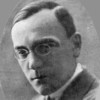

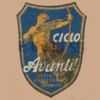


Growth
of the Red Cyclists
Even in 1914, on the
occasion of the "Red Week" riot, between June 7th
and 14th,
the bicycle showed its usefulness for gathering and circulation
of news, seen the isolation due to the sabotage of telephone and
telegraph cables and railways. On the occasion, the fascist writer
from Forlì Antonio Beltramelli
saw in the use of bicycle to organise the workers' occupation
of the city a new means of the siege laid by the "countryside"
to the "city" (Baroncini).
The Socialist Youth congress, scheduled for September 1914 in
Reggio Emilia, was postponed due to the outbreak of war.
The socialist journals published the advertising
of «Carlo
Marx» tyres, presented as the «tyre
of Italian Socialists» and
of «Ciclo
Avanti! », whose trademark was registered
on September 18th, 1913 by Alcyon Officine, of
brothers Cesarani of Caravaggio (province of Bergamo), who probably
were the same to publish, in the same year, the book of Antonio
Lorenzini. An advertisement on the "Avanti!"
on summer of 1913 declared, "No bicycle can, by elegance,
by resistance, by fluidity, and by cheapness, be compared to the
"Ciclo Avanti". A bicycle bound to spread rapidly
throughout Italy, especially among workers". (Boschi)
To strengthen the spirit of belonging and to gather sympathizers,
the FNCR organized in Imola a series of cycling propaganda
tours: the first was held on April 8th, 1917, the Easter day, departing
at 1:00 PM from the Ponte Santo (Holy Bridge), a bridge on Santerno
river, at that time called by the Socialists of Imola "Ponte
Rosso" (Red Bridge). A footage of this tour (see photograms
1, 2
and 3), was released in 2010
on DVD by Bacchilega of Imola, directed by Fausto Pullano with
music by Roberto Bartoli. It includes the restored version with
soundtrack of two footages of 1910 and 1913, kept in Imola by
CIDRA
(Centro Imolese di
Documentazione sulla Resistenza Antifascista e storia contemporanea
- Imola Center for Documentation on Anti-Fascist Resistance and
Contemporary History).
The second ride took place three Sundays later, on April 29th,
departing at 1:00 PM from the same bridge, arriving after about
20 km at San Patrizio, a hamlet of the town of Conselice, in the
province of Ravenna, where a public meeting was held, ended by
a final vote of an agenda. On May 13th, the Imola Red Cyclists, together
with those of Lugo, gathered in Mordano, in the province of Bologna,
for the first meeting between two electoral constituency, and
on May 20th organized a propaganda trip to
Sesto Imolese. The last propaganda ride of 1917 was Sunday, August
19th at Osteriola, where the Red Cyclists also
gathered on July 21st, 1918 for an electoral constituency
meeting.
The last survivor of Imola Red Cyclists was Ottavio Zanelli (link), born in Ravenna on September
26th, 1904, and dead on April 6th,
2006 at the age of 101 years, after a long political activity,
from the Leghorn Congress of 1921 that saw the foundation of the
Communist Party of Italy, to the
detention for his opposition to the fascist regime, to the Resistenza,
until his post-war political activity. (Giannantoni and Paolucci)
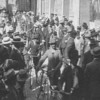

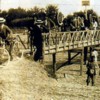
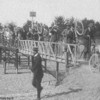



The Red
Cyclists in the 1920s
The role of Red cyclists
in the 1920s was important in the workers fight of the first afterwar,
for employment and against fascism. During the strikes, the Red
Cyclists helped to quickly form picket lines against the scabs,
indeed during the August 1920 agrarian strike, the prefect of
Reggio Emilia forbade the use of bicycles throughout the province.
In 1921 a team of Reggio Emilia Red Cyclists escorted from Reggio
to Cavriago the bodies of two workers killed by the fascists on
1st May (Fincardi, 2012b), and in Piombino (province of Leghorn)
on August 3rd, 1921, a squadron of cyclists
Arditi del Popolo (People's
Arditi, the Arditi were an elite corps) opened the funeral
procession accompanying the body of the worker Giuseppe Morelli,
a member of the Arditi del Popolo killed by law enforcement officers.
The communist newspaper L'Ordine Nuovo of
July 24th, 1921 reported the facts of Cingia
de' Botti (province of Cremona), where on 17th
of July six hundred Red Cyclists paraded through the city streets,
lined up as soldiers, in order to reach the local branch of fascist
party to force them to hand over the pennant. (Francescangeli) In the province of Venice, at Cavarzere,
a large group of Arditi del Popolo, about two hundred, spread
among the various hamlets of the municipality, keeping in touch
among them by means of cyclist dispatch riders. At Trieste the
Red Arditi, established before the People's Arditi, were organized
in twelve teams, including a female and a cyclist squadron. The
Red Cyclists were widespread in Polesine, Cremona province and
Julian March. (Francescangeli) In Rome, the Cyclists Arditi
took care of the connections between the central and peripheral
units of the Arditi del Popolo and were particularly active in
the defense of San Lorenzo and other popular neighborhoods from
the aggression of fascist, who had reached Rome in order to take
part in the fascist party's foundation congress, from 7th
to November 11th, 1921. The Arditi cyclists also
succeeded in quickly moving men from one neighborhood to another,
depending on the needs created by the fascist attacks. (Gentili)
The cycling champion
Ottavio Bottecchia, winner of two
Tour de France, in one of which he wore the yellow jersey from
the first to the last stage, put in place anti-fascist activity
and was therefore assassinated in 1927.
Red (or
not) Cyclist women
The bicycle also became
a tool for female emancipation, thanks in particular to some pioneers who defied
the contempt and the insults of the conformists. The president
of the feminist meeting in Paris in 1896 proposed a toast to the
"egalitarian and leveling" bicycle. The catholic
movements found the use of bicycles, and therefore of pants, inappropriate
by women (Boschi). As Blom wrote: «The
moralists were scandalized by the effect these anarchic vehicles
would have on public morals, most especially on women, who pedalled
along gleefully, having discarded their corsets and put on more
practical clothing, including trousers. Meanwhile scientists gravely
warned that the sheer rush, as well as their position - boldly
astride the saddle - would stimulate women beyond endurance and
reduce them to infertility, hysteria or worse, wanton creatures
without any restraint.»
(Blom)

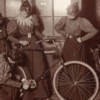




A decisive incentive was
given by the first velocipedist women which were seen in Milan
in 1891, and in 1893 first participated in rides and competitions
(in 1894 in Genoa the first women's cycling race in Italy was
held) and took part in the parade at the cycling meeting organized
in Ferrara in 1902 by the Touring Club Italiano. Among the best-known
agonist cyclist women we find the Milanese florist Adelina Vigo,
the future opera singer and actress Lina
Cavalieri, winner of the stage race Rome-Turin, at the end
of the nineteenth century, who challenged each other in 1893 in
Milan, Alessandrina Maffi, Italian champion from 1893 to 1897,
who often defeated male cyclists, as happened in the Audax Speed
Award of 1898, that she won riding for 180 km in less than 18
hours, Maria Forzani, winner of the Milan-Varese in 1896, Hélène Dutrieu from
Belgium (1877-1961) and Vittorina
Sambri from Ferrara (1891-1965), which soon became a motorcycle
racer (Caracciolo,
Gori). The best known
cyclist woman was however Alfonsina
Morini Strada (1891-1959)
from Modena, awarded
by Tsar Nicholas II in person for her participation in the 1909
Grand Prix of Petersburg. Morini took part in the Giro di Lombardia,
in 1917 and 1918, reaching the finish line, while half of the
competitors who had started did not finish. Morini took part in
1924 in the Giro d'Italia, with 90 male competitors, where she
finished outside the time limit in one of the last stages, L'Aquila-Perugia,
also because of the very frequent stops to sign autographs along
the way, but was allowed to participate until the end, even though
her time was not taken. Alfonsina Morini also took part in other
editions of the Giro d'Italia and won 36 races, defeating also
male competitors. (Izagirre)
After the Second World
War, bicycles played a key role in the labourers' fights, so that
the special police squads of Minister of the Interior Mario Scelba
frequently seized or destroyed them. Thousands of bicycles followed
in 1949 the funeral of Maria Margotti, a labourer from Filo d'Argenta,
near Ferrara, killed by a policeman (Caracciolo).

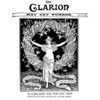
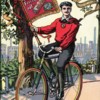


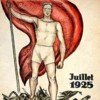
Red Cyclists
in Europe
Proletarian sports
organizations also existed in other European countries, in the
last decade of the century groups of socialist cyclists were formed
in Austria and Switzerland. In Germany, in 1893 in Leipzig the
Workers' Cycling Solidarity Club was created, later prohibited
by anti-socialist laws, alongside similar associations of gymnasts,
swimmers, yachtsmen and track and field athletes. In
February 1894 at Birmingham, in England the Socialists' Cycling
Club was founded, which later took the name of Clarion
Cycling Club, from the socialist weekly journal The
Clarion. In 1895 the British Workers' Cycling Club
was established. (Wheeler)
In 1896, at Offenbach
am Main, in Germany, the Red Cyclists Association (ARS:
Arbeiter-Radfahrerbund Solidarität Cyclist Workers Association)
currently Rad- und Kraftfahrerbund
Solidarität, was established, which in 1912 had 150,000
members. The newspaper Arbeiter-Radfahrer in 1913 declared 168
thousand copies. In 1929 the association had 320,000 members,
and was the largest world cycling organization, it also run a
bicycle cooperative factory, and organized promotional sports
events. At the time of the First
World War, the proletarian sports associations had more than 350,000
members.
On June 23rd, 1921, in Moscow, the Red Sports
International was founded with representatives of Germany, France,
Italy, Hungary, Czechoslovakia, Sweden and the Netherlands, representing
the revolutionary wing of sport movement, opposed to the Socialist
Workers' Sport International (Lucerne Sport International),
founded in 1920 in Lucerne, Switzerland, with a reformist inspiration.
(Gounot)


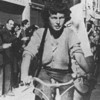
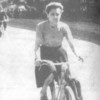

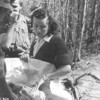


The cyclists
in the Resistenza
During the Resistenza,
as anticipated, the bicycle was used as a means of connecting
the partisan bands, but also to carry out war actions, to escape
the police after the extemporary flash speeches in the cities,
and to deliver weapons, food and propaganda material. This involved
many Partisan women who risked (and often lost) their lives to
deliver by bicycle messages, food, and weapons to the rebel bands
sheltered in the mountains (see photos in the row above, click
to enlarge them).
The partisan Renato Romagnoli ("Italiano")
in his book
of 1974 «Gappista.
Dodici mesi nella Settima Gap "Gianni"»
(«"Gappista".
Twelve months in the Seventh Gap "Gianni"»), published
by Vangelista, quoted by Giannantoni and Paolucci (2008), tells: «Very soon every bicycle became
a nightmare for the nazis and fascists, in every cyclist they
saw a rebel ready to shoot at the occupying troops, to hit their
servants wearing black shirts; the chronicles of time are full
of proclamations and announcements on the permitted uses and on
the banned ones of the popular means of locomotion, no fascist
or German, except those in a group, had the courage to stop a
man on a bicycle (and when enemies do group they are visible from
a considerable distance so it becomes easy to manage to dodge
them). Announcements and proclamations remained ineffective.»
Consequently, fascists
in various places banned the use of bicycles (see the announcements
of Carpi
and Bologna).The
same book of "Italiano" mentions some passages
of an announcement published in Bologna on April 26th,
1944: «From April 26th,
1944, it is absolutely forbidden to circulate with bicycles, even
dismounting and walking them, within the perimeter of the city
of Bologna bordered by the avenues (…) Those who live within
the above described perimeter and who, for work reasons, have
to move by bicycle from the interdicted area to the suburbs and
then go back to the city centre must have a special statement
of their employer, endorsed by the Bologna central police station,
but for the entire interdicted perimeter and roads they will have
to dismount and walk alongside their bicycle, deflating the tires
of their wheels or disconnecting the chain from the sprockets
and the chainring.»
A similar ban, with a threat of summary execution in case of violation,
is mentioned by "Italiano" referred to Ravenna.
In Milan and Turin the same announcement didn't last long, since
the bicycle was the only means by which workers could reach the
factories, which were fundamental to supporting the nazi-fascist
war effort.






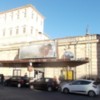


In Milan, the bicycle
was fundamental to the implementation of many partisan warfare
actions, and in particular Giovanni
Pesce stood out, with battle names "Ivaldi"
and "Visone", who scored many attacks against
the fascists thanks to this vehicle. Pesce explained «It
was like the air I breathed, an indispensable means to move quickly
in every moment. Without the bicycle, it would not have been possible
to carry out the actions I performed.». On April 24th,
1945, the general insurgency order was delivered by cyclist dispatch
riders. (Giannantoni
and Paolucci)
In Rome, during the
nine months of the nazi occupation, the bicycle was used to carry
at least two major attacks on December 18th,
1943 by Rosario Bentivegna in front
of the Barberini movie theatre,
in the square of the same name, to hit the attendants to a movie
show dedicated to nazi soldiers, and December 26th,
1943 in front of the Regina Coeli jail gatehouse,
by Mario Fiorentini. (Portelli) The
attacks provoked the ban on cycling in the city, which was bypassed
adding a third wheel to the vehicle, turning the byke into a tricycle.
The great cycling champion Gino Bartali
(1914-2000), from Florence, exploiting his popularity as a sports
champion, used his bicycle to hide fake documents in the frame
tubes, in the handlebar and in the saddle, that he delivered to
Jewish citizens, hiding in a convent of Oblates Friars in Lucca
(about 90 km, 56 Mi from Florence) and Assisi (160 km, 100 Mi
from Florence, where he went 40 times), allowing them to show
to be "aryans", thus saving 4,000 of them from
extermination. (Sbetti;
Stevenson). Bartali
disguised his deliveries as training to keep fit, despite the
suspension of sport activity (the Giro d'Italia was suspended
since 1941), and when he was stopped for checks, he asked not
to touch the bike because it was carefully calibrated to achieve
maximum speed (Stevenson). Bartali also concealed the Jewish
Goldenberg family in a cellar of his home in Florence until the
liberation of the city in August 1944 (Coen; Stevenson). For this reason, after his death,
Bartali was awarded by Italy the posthumous gold medal for civil
merit, and by Israel the honorific of
"Righteous
Among the Nations" and his name was engraved
in Yad Vashem garden. Bartali's activity was known only by his
family and by those who collaborated with him, and it was made
known only after his death, since Gino didn't consider it was
appropriate to take credit for it: he had told his son Andrea,
"One does these things and then that's that."
The cycling champion from Varese Luigi Ganna,
the winner of the first Giro d'Italia in 1909, had become a bicycle
manufacturer, and in 1944 donated ten of his bicycles to the 121st
Brigade Garibaldi
"Walter Marcobi".
(Giannantoni
and Paolucci) Also
Alfredo Martini (1921-2014) cyclist
rider and then for 22 years team manager of the Italian national
cycling team, Luciano Pezzi, cyclist
rider and then technical director
of many champions,
among them Felice Gimondi, and many other professional athletes
were partisans.
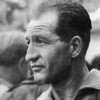
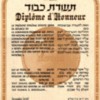




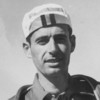



Red Cyclists
today
In more recent years,
the bicycle resumed its role as a workers' dispatch rider between
factories fighting against layoffs or closing of factories. In
2009, on the occasion of the Giro d'Italia, workers from Veneto
and Tuscany with temporary employments or receiving unemployment
benefits made a parallel tour between factories occupied by workers.
(Satta,
2009) In 2013, Romagna
Socialists organised a commemoration of
Red Cyclists, on the occasion of the centenary of the establishment
of the movement.
On 25th April, 2015, in order to celebrate
the 70th Anniversary of Liberation and
the role of Women's Defense Groups in the Resistenza, the UDI
(Unione Donne in Italia,
Women's Union in Italy) of Modena, together with FIAB (Federazione
Italiana Amici della Bicicletta, Italian Federation of Bycicle's
Friends), organised a bicycle
trip in the more significant places of the city
for the political history of the age.
ZeroLire Edition at Forlì publishes on-line several
works on bicycle and on its social life.

Bibliography:
BARONCINI
Enrico (2012) Pedalanti eserciti. La bicicletta nella settimana
rossa romagnola. In: Fincardi, 2012 (editor): 105-117.
BLOM Philipp (2012) The Vertigo Years: Change and Culture in the
West, 1900-1914, Weidenfeld & Nicolson, London.
BOSCHI Massimiliano (2003) 1913, allarme a Imola. Arrivano i "ciclisti
rossi". Il Venerdì di Repubblica, n. 784 (March
28, 2003), pag. 51-52.
CAGNOLATI Antonella (editor) (2011) Donne e bicicletta : una relazione
pericolosa? Aracne, Roma.
CARACCIOLO Carlos Hector (2011) Donne, uomini e biciclette. Appunti
per una storia italiana. In Cagnolati, pag. 37-61.
CARNERO Roberto (2003) Anno 1900: Oriani e l'arte della bici.
L'Unità, 22 aprile 2003, pag. 16.
CAVALLARO Claudia (2017) Tra discriminazioni e dilettantismo:
le cicliste che hanno fatto la storia in Italia. Soft Revolution,
May, 24 2017 link
COEN Leonardo (2013) Bartali, cuore di campione così salvava
gli ebrei. Repubblica Firenze, cronaca, September 23, 2013
link
DIRANI Ennio (1993) Cicloturismo romagnolo: 1894-1994 : per i
cento anni della bicicletta di Oriani. A. Longo, Ravenna. From:
Edizioni ZeroLire website link
FINCARDI
Marco (2012a) Il movimento dopo il lavoro. In: Fincardi, 2012
(editor): 5-14.
FINCARDI Marco (2012b) Ciclisti della Camera del Lavoro nel 1°
maggio reggiano (1902-1922) In: Fincardi, 2012 (editor):
189-210.
FINCARDI Marco (a cura di) (2012) Lo sport e il movimento
operaio e socialista. L'Almanacco, Felina (RE), n. 59, giugno
2012: 5-14. link
FONTANA Gian Franco (1995) La bicicletta, Università
aperta terza pagina, Imola (BO). (5), 11: 26-27.
FRANCESCANGELI Eros (2000) Arditi del Popolo. Odradek, Roma.
GENTILI Valerio (2009) La legione romana degli Arditi del Popolo.
Purple Press, Roma.
GIANNANTONI Franco, PAOLUCCI Ibio (2008) La bicicletta nella Resistenza.
Storie partigiane. Arterigere-Chiarotto Editore.
GIUNTNI Sergio (2012) La Patria socialista: una società
ginnastica carpigiana dall'Ottocento al Fascismo. In: Fincardi,
2012 (editor): 119-136. link
GORETTI Leo (2012) "Sacrifici, sacrifici e ancora sacrifici"
Sport, ideologia e virilità sulla stampa comunista (1945-195)6
In: Fincardi, 2012 (editor): 161-187.
GORI Gigliola (2011) Muliebris birota velocissima. Il ciclismo
femminile in Italia fra XIX e XX secolo. In Cagnolati, pag. 63-88.
GOUNOT André (2001) Sport or Political Organization? Structures
and Characteristics of the Red Sport International, 1921-1937.
Journal of Sport History, vol. 28, n. 1, pages. 23-39.
link
IZAGIRRE Andres (2015) ¿Por qué el ciclismo es una
'religión' en Italia? CNN Edición Español,
9 May 2015 . link
LA LOTTA (1917) Organo della Federazione collegiale socialista
Imolese. 17, 19, 20.
LOMBROSO Cesare (1900) Il ciclismo nel delitto. Nuova Antologia
di Lettere, Scienze ed Arti», vol. LXXXVI, IV serie, vol.
CLXX. Roma, link
LORENZINI Antonio (1913?) I ciclisti rossi: i loro scopi e la
loro organizzazione. Fratelli Ceserani, Caravaggio.
PETRINI Giovanni (1904) Lo sport e la questione sociale. Avanguardia
socialista, 1 May, 1904. In Pivato, 1992: 227-230.
PIVATO Stefano (1992) La bicicletta e il sol dell'avvenire: sport
e tempo libero nel socialismo della Belle époque. Ponte
alle Grazie, Firenze.
PIVATO Stefano (2011) La rivoluzione silenziosa. In: Cagnolati
pag 15-20.
PIVATO Stefano, VERI Loretta, CANGI Natalia (editors) (2009) In
bicicletta : memorie sull'Italia a due ruote. Il mulino, Bologna.
PORTELLI Alessandro (2012) L'ordine è già stato
eseguito. Feltrinelli, Milano.
REGAZZONI Marco (2015) Tour de France 2015: i trionfi e lo strano
incidente di Ottavio Bottecchia. www.oasport.it link
RIDOLFI Maurizio (1993) Socialità popolare. Università
aperta terza pagina, Imola (BO). (3), 6: 4.
S.A. (1921) L'inquadramento dei ciclisti rossi. L'Ordine Nuovo,
24 July 1921, pag. 5, link
SASSO Cinzia (2010) Dal campo di concentramento alla libertà
la storia partigiana della 'staffetta' Sandra. Repubblica Milano,
26 November 2010 link
SATTA Andrea (2009) Ciclisti rossi cercasi. In bici tra gli operai.
L'Unità, 24 May 2009, pag. 43.
SATTA Andrea (2014) Libri nel Giro, Andrea Satta: "I ciclisti
rossi". La Repubblica, Sport, 28 May 2014 link
SBETTI Nicola (2015) Giochi diplomatici. Sport e politica estera
nell'Italia del secondo dopoguerra (1943-1953). Doctoral dissertation,
University of Bologna. link
SENATORI Luciano (2011) Associazionismo sportivo, proletario e
popolare nell'Unità d'Italia. Stile Libero - Sport&Sicurezza,
VIII, 2, Mar-Apr 2011, pag. 25-28 link
SENATORI Luciano (2014) Sport moderno e sport popolare. UISP
Lega Pallavolo Nazionale - Corso per Formatori Giudici di Gara
e Allenatori - Firenze 15 - 16 November 2014. link
STEVENSON John (2013) Gino Bartali awarded Israel's Righteous
Among The Nations for wartime activities. http://road.cc/,
September 28 2013 link
TACCHINI Alvaro (s.a.) Lo sport: una "epidemia". Storia
tifernate e altro. link
TARANTINI Domenico (1975) La maniera forte : elogio della polizia
: storia del potere politico in Italia, 1860-1975. Bertani,
Verona. pag. 177.
WHEELER F. Robert (1978) Organized Sport and Organized Labour:
The Worker's Sport Movment. Journal of Contemporary History,
13 (2): 191-210. link.
ZANELLI Giuliana (2002) Ciclisti rossi. Università aperta
terza pagina, Imola (BO). (12), 8: 10.
ZIBORDI Giovanni (1909) Sport, ginnastica e proletariato. Alla
vigilia della discussione del disegno di legge per l'educazione
fisica. In "Avanti!" 18 November, 1909. In Pivato,
1992 255-261.
Visited Websites:
ANPI
Mirano link
Ciclo Imprese
Estreme - Romagna - Bicicletta & Politica, 2 Maynd 2014 link
Comune di Imola, Biblioteca Comunale di Imola. Pedalata dei ciclisti
rossi a favore della propaganda socialista. link
Federazione
Giovanile Comunisti Italiani - Sezione "John Reed" Imola link
Formazioni di difesa proletaria, Wikipedia link
I ciclisti rossi link
Museum der
Arbeit - Das Fahrrad link
L'Osservatore
Romano archive link
Partito Socialista
Italiano di Ravenna e della Romagna link
Storia e
Memoria di Bologna - Ottavio Zanelli link
UDI - Io vado ... come una staffetta link
 page created: August 29th 2017
and
last updated: March
1st. 2025
page created: August 29th 2017
and
last updated: March
1st. 2025